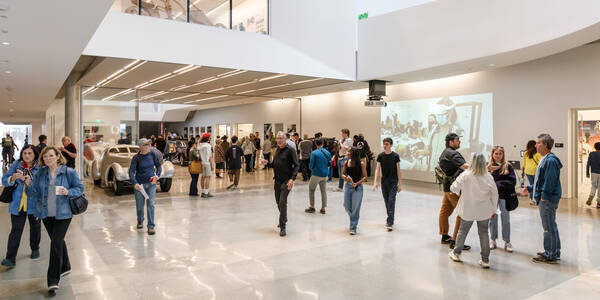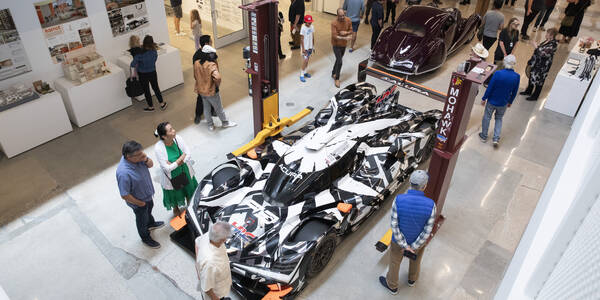feature / alumni / transportation-design / interaction-design / media-design-practices / entertainment-design
June 10, 2024
By Solvej Schou
Alumni reflect on the future of car design and AI at ‘Beyond Supersonic’ panels
At ArtCenter’s ‘Beyond Supersonic’ celebration of South Campus, alumni discussed the future of car design and of AI and creative work at panels in the brand-new Mullin Transportation Design Center.
On Saturday, during ArtCenter’s monumental “Beyond Supersonic” celebration of the 20th anniversary of the College’s South Campus, and the unveiling of several new learning spaces—including the brand-new Mullin Transportation Design Center (MTDC)—alumni and faculty professionals from an array of backgrounds reflected on the future of car design and of AI in two panels.
The pair of filled-to-capacity panel discussions took place inside a second-floor 99-seat “flex-space” media center in the MTDC, the new home of the College’s renowned Transportation Design program. For both panels, alumni, students, faculty, staff, donors and design lovers packed the room.

In the panel “The Future of Car Design: Changing Roles and Responsibilities, Tools and Processes,” marking a pivotal moment honoring the 75th anniversary of the Transportation Design program, moderator and Transportation Design Chair Marek Djordjević (BS 91 Transportation Design) led an in-depth conversation on the transformative landscape of automotive design, and emerging trends, innovative tools and evolving design processes.
The panelists were Ian Cartabiano (BS 97 Transportation Design), vice president of advanced design, Calty Design Research, Toyota/Lexus; Derek Jenkins (BS 93 Transportation Design), senior vice president of design and brand at Lucid; Nadya Arnaout (BS 00 Product Design), associate vice president of interior design and CMF (colors, materials, finish) design at Fisker; and Daniel Jimenez (BS 15 Transportation Design), chief designer at Nissan Studio 6.
“We can’t just style stuff—we have to think deeply about what we’re making and why,” said Cartabiano, who mentioned that he sold furniture before he attended ArtCenter, and pointed out that Jimenez used to be an ArtCenter student of his, when he taught at the College, and that one of two his Calty mentors and one his Calty interns were all sitting in the audience. Asked about the importance of leadership and mentorship, Cartabiano spoke powerfully.
We can’t just style stuff—we have to think deeply about what we’re making and why.
Ian CartabianoVP of Advanced Design, Calty Design Research

“The thing that I learned that I love is inspiring my team,” he said, breaking down leadership into five categories: clear communication, trusting your design team, building up the future generation of designers, learning that everyone is an individual, and leading with a positive attitude. “Design is tough,” he said. “You work on something, you work on something, you work on something. It can be cancelled the next day. We just went through this, and the young team members are heartbroken. I’m like, ‘Hey! This happens, but we have another chance to do something tomorrow.’”
Arnaout, who used to work at BMW, and also various startups, mentioned not having as much exposure to marketing and product planning as now, when it comes to emerging processes. “You have to collaborate, you have to be very pro-active, you have to see everyone’s side in this business,” said Arnaout. “Working for a startup, it’s even more intense. You’re almost in a pressure cooker, not in a bad way. You get infiltrated with all this information from other departments. The collaboration is so important.”
Jenkins noted the opportunity at ArtCenter to explain to students just why design is so important. “You can empower not only yourself, but also the whole organization with your tools, with your passion, with your words, with your actions,” he said.
As for future trends, the panelists talked about cultural differences interacting with AI and UX technology—varying between countries, when it comes to issues of privacy—and sustainability as now being the baseline for the industry, with consideration of how to make sustainable designs both cost effective and also desirable for customers. A door panel, for instance, could be made out of three parts and not 13, said Jenkins.
“We have to start thinking about the vehicle, the product in general, as assuming a lot of responsibility,” said Jimenez. “It’s very multifunctional. These products are almost becoming a Swiss Army knife, or can do one thing very well. There’s technological advancement, and there’s also a yearning to go more analog, to feel stuff, to touch stuff. And why not upcycle some previous products?”

In the second panel, “AI and the Future of Creative Work,” hosted by ArtCenter’s Media and Technology division, moderator Todd Masilko (BS 96 Product Design), chair of the College’s Interaction Design and graduate Media Design Practices departments, led a nuanced discussion on the transformative effects of AI-powered creative tools on designers and artists, and—from disruptions to ethical considerations and new opportunities—examples of innovative ArtCenter courses, recent student work and their meaning for education at ArtCenter.
The panelists were Entertainment Design Professor Eric Roth, who teaches a virtual production course; Kelly Weldon (BS 16 Interaction Design), a staff experience designer at Adobe, who works on the company’s Adobe Firefly AI tools; Thom Meredith (BFA 04), an Interaction Design instructor who teaches the course Next of Web, and is a partner and director of technology at the digital agency Kley; and Jenny Rodenhouse (MFA 15), associate chair of Interaction Design and director of ArtCenter’s transdisciplinary Immersion Lab.
Weldon, who works on generative AI video and audio, was asked about recent changes and trends in the field. In 2023, ArtCenter students from 10 different degree programs took part in a three-day extra-curricular Adobe-sponsored DesignStorm workshop on AI.
“AI moves so quickly, and there are new tools, it feels like, every week,” Weldon said. “As a creative, I have an opportunity to direct how we as a team build these products, what we do with them, what we allow ethically and responsibly, and that’s what I’m excited about. I get to research these AI tools every single day and try to keep up with them. The speed of change is what’s been really surprising to me. Exciting, scary and hard to keep up with.”
As a creative, I have an opportunity to direct how we as a team build these products, what we do with them, what we allow ethically and responsibly, and that’s what I’m excited about.
Kelly Weldon
Staff Experience Designer, Adobe

Roth said that his virtual production course empowers students to figure out how to create their visions and easily bring them into the 3D creation tool Unreal Engine to tell their stories. He cited the Disney+ television show The Mandalorian as a place where innovation has been pushed, when it comes to virtual production. “You’re taking an idea as an artist and then trying to get it as fast as you can on screen, on set, and then the ability to not only take that idea and lock it in, and have the control of that environment, but switch scenes immediately,” he said.
Rodenhouse noted that the Immersion Lab has been working with companies such as Meta Reality Labs, and that it focuses on technology centered research. She also mentioned that the lab explores computer vision, and how a computer “sees,” she said, from a wall to a floor, with it being trained on millions of data points. “How do we move students away from just saying, ‘It knows everything—the AI can do it,’” Rodenhouse said. “Let’s really dig into that and challenge our assumptions.”
Meredith told the audience, to laughs, about he and his daughter using Midjourney text prompts to create polka dot floating cows on floating rafts in the middle of the ocean. He was able to experience the pleasure of his then 9-year-old daughter interacting with AI and creating something that had never existed, he said. In his course, students created, using Midjourney, photorealistic images of humans, and they also worked with AI on giving content a brand voice.
“You still need to know what good design is,” said Meredith. “Being able to have multiple options to choose from, you still need to know when to stop, when you’re done, and when this solves the problem. Being able to utilize these tools to help us visualize potential solutions that might solve that problem faster is really great.” Added Weldon, of AI, “It opens up the possibility to ideate faster, visualize ideas and figure out the direction you want to move in, and figure out if you’re doing the right thing. That’s a big part of user experience design.”





